PART 6: WHAT SHALL WE GROW TO EAT? |  |
Improving nutrition |
| Objectives |
Deciding what do to plant by:
|

 | Here we concentrate on growing food to eat. Deciding what to grow is the subject of this part. Deciding what to do with it after harvesting is dealt with in Part 9. Before coming to a final decision about what to grow, consult Part 9 as well. |
| The “practical purpose” of growing food is to improve children’s diet. Its educational aims are to show how this can be done and to raise awareness of nutrition issues. |
The school garden cannot usually provide a large part of children’s diet. One reason is that the children are not at school all year. Another is that they do not have time to grow a great deal in the garden. But the garden can have a strong influence on what children eat:
It can increase the variety in the diet, adding essential vitamins and minerals in fruit and vegetables, and extra protein (for example, from beans or eggs). Small amounts of poultry or meat are important for adding minerals like iron and zinc that are essential for child growth and intellectual development.
It can create a taste for a variety of nutritious foods so that children and their families will plant and cook more varied and nutritious foods themselves.
It can extend and balance school meals. Many schools only receive dry staple foods for school meals or take-home rations. Fresh fruit and vegetables from the garden can make all the difference to creating well-balanced and varied meals.
It can provide snacks to keep children going. Breakfast and mid-morning snacks and drinks are especially valuable since they give children energy for the whole morning. Children can learn how to make their own snacks from garden food or food produced at home.
It can build awareness in children and their families of what makes a healthy diet.
It can promote crops that are neglected and undervalued, or that can be stored/preserved for the hungry season.
All these influences are most effective when school gardens are taken as a model and imitated by children and families in the home garden. In this way the school garden shows what can be done, and its influence is multiplied.
Schools talk about gardens and food
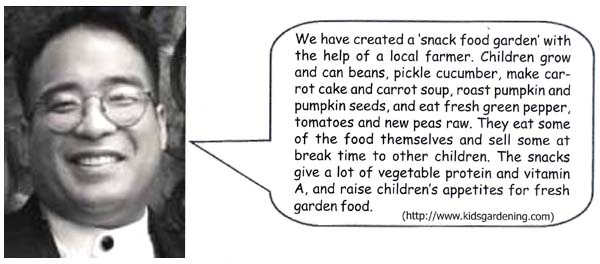
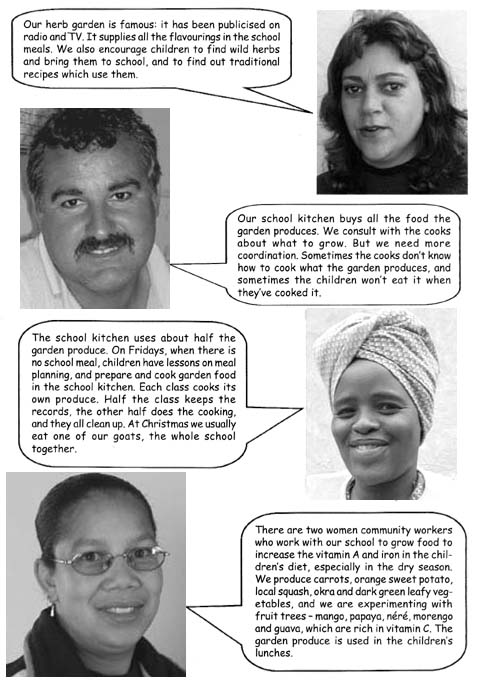
You may already have a good idea of what food to grow. If not, get information and advice from parents, children, nutritionists and health workers, horticulturists, local gardeners, home economics teachers, and consult the school meals programme. Discuss these questions with them:
A. MALNUTRITION: IS THERE A PROBLEM?
Many children in poor countries and communities have inadequate and unbalanced diets, which result in malnutrition. Children’s growth and behaviour are good indicators of their overall health. If they are small for their age, tired, unable to concentrate and frequently sick, they may be malnourished. The three main kinds of malnutrition are:
Undernutrition When children are not getting enough of the right mix of foods, they are tired, fall ill easily and do not grow well. They may also have problems learning at school.
Overnutrition If children eat too much, do not get the right mix of foods, and do not have enough exercise, they can become overweight. This may lead to adult overweight or obesity and many health problems.
Micronutrient malnutrition Many children do not get enough of some essential vitamins and minerals.These “micronutrients” carry out vital tasks which make the body work well. They give good sight and skin, protect the body against disease, help to release the energy in food, allow the brain and body to develop properly, and so on. It is estimated, for example, that a million children die each year because they do not have enough vitamin A. Most vitamins and minerals are available in foods which can easily be produced in home or school gardens. Often people simply do not realize that these foods are essential for health.
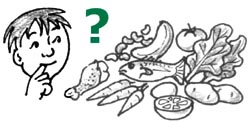
For more information about the problems, effects and symptoms, see the Nutrition Factsheets Hunger and malnutrition and Energy and nutrient needs.
→ Are these serious problems in your area? Is there undernutrition or micronutrient malnutrition? Consult health services, local nurses or community workers.
B. WHAT KIND OF DIET DO CHILDREN NEED?
A diet is not only what you eat, but also how you eat it, how many different things you eat, how often and when.
1. What foods should our children be eating?
To grow into healthy intelligent adults, children need to be eating all these foods regularly:
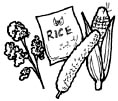 | Cereals (e.g. maize, millet, sorghum, rice, wheat) provide a lot of energy, protein and (if eaten as whole grains) substantial amounts of vitamins B and E . To get their full food value they should be eaten with many other foods. |
 | Roots and tubers (e.g. cassava, taro, yam, sweet potato, potato) are also very good sources of energy and some vitamins, but have less protein than cereals. They should be eaten with many other foods. |
 | Legumes (e.g. cowpeas, chickpeas, beans, soybeans) are a rich source of protein. Some also have fat, vitamin E, calcium and others have iron and zinc, which children need to grow and to develop their brains. |
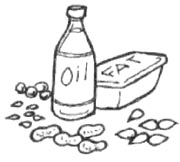 | Oilseeds, nuts, fats, oils are the most concentrated sources of energy. Even in small quantities they can make a big difference to the diet of physically active children. Those from plants (e.g. groundnuts, sunflower seeds, soybeans, sesame, olive, rapeseed) are the most healthful. Some also provide protein and vitamin E. Red palm oil is very rich in vitamin A. Groundnuts are an excellent snack for children but should not be very salty. |
 | Vegetables and fruits are rich in many different vitamins and minerals and other substances which protect our health, especially dark green leafy vegetables and yellow or orange fruits and vegetables (e.g. pumpkin, yellow/orange sweet potatoes, papaya, mango, carrots). Dark green leafy vegetables release all their nutritional value when combined with other foods. Children should eat five different types and colours of vegetables and fruits every day (dark green, yellow/orange, red, citrus and legumes). |
 | Animal foods are rich in high-quality protein and minerals, such as iron and zinc. Milk and cheese provide calcium for strong bones, while chicken eggs provide vitamins A and D as well as protein. Small fish, if eaten whole with the liver, are rich in vitamins A and D and iron. Unless children eat fish or seafood daily, they should always use salt fortified with iodine. |
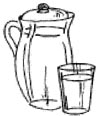 | Water is nearly 80 percent of the body and is essential to its working. It flushes out wastes, maintains the volume of the blood and keeps body salts in the right concentration. Everyone needs to drink plenty of clean water every day, especially people who live in hot climates and are physically active. |
The Nutrition Factsheet Nutrients in foods shows some foods which are rich in the various nutrients necessary for growth, energy and health.
→ Are your schoolchildren getting enough of all kinds of food? What in particular do they need?

2. Good meals
A well-balanced meal is usually based on a staple food - a cereal, root or tuber (for example, rice, potato, bread, cassava, maize). This is commonly eaten with a relish which may have fish, meat or legumes, and vegetables. Dark green leafy vegetables and orange vegetables are particularly good. A little oil or fat helps to absorb the nutrients in the vegetables. Flavouring is very important for making the meal tasty. Finally, every meal should finish with a piece of fruit.
The Family Mixed Meal Guide

→ Are your children getting well-balanced meals? At school? At home?
3. Variety
It is not enough for children simply to have a lot of food. It is not enough even if all their meals are well-balanced. To provide everything the body needs, we need variety: many different grains, roots and tubers, vegetables, fruits, legumes and nuts, and animal foods. Children need this variety every day, and all year round.
There are many reasons why people do not have enough variety in their diet. They may not be able to get to markets. Often there are not many foods available in the market or supermarket or there may be seasonal shortages.
People can run out of foods they need at stressful times - for example in the winter, when they need extra food to keep warm, or when they are doing heavy work on the land and need extra energy and nutrients. Often people do not think that variety is important, so they actually choose to eat the same foods all the time. They may think that fruits and vegetables are not worth eating or they simply do not like some foods because they are not used to them. Many children, for example, grow up eating few fruits and vegetables, and this creates habits and preferences which are hard to change later.
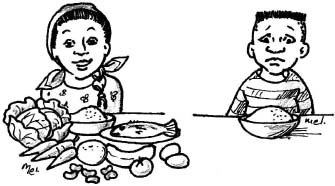
→ Are your children getting enough variety in their diet? Something different every day? Different foods throughout the year?
Vegetables add variety
| In the Toledo district of Belize, “slash-and-burn” agriculture has impoverished the soil. The local diet is mainly maize, with rice and beans. Vegetables have low status and are regarded as “hard-time food”. There is widespread malnutrition. |
 |
| Children in Belize show off some of their harvest Photo © Plenty International* |
| School gardens and school meal programmes are aiming to improve the situation. They are helped by the NGO Plenty Belize with backing from UNICEF, the Pan American Health Organization (PAHO), the local university and the regional education committee. The school gardens grow calaloo, cabbage, peppers, cucumbers, tomatoes, carrots, papaya, mango and plantain. Hibiscus hedges keep out the main marauders, domestic pigs; one school collected enough money for a chain-link fence. Schools use natural methods of pest control: bug picking, intercropping and an insect spray made with onions, garlic and peppers. The produce is sold mostly to the school kitchens. Schools in the scheme meet once a month to exchange ideas and collaborate on finding donors. Families, at first suspicious, now support the gardens, because, as the project coordinator says, “agriculture is really their best bet to keep on living”. |
| (M. Miller, personal communication, 2004) |

4. Frequency
Many children have only one meal a day. This is not enough. Growing children need to eat often, up to five times a day. They need something to eat before school to give them energy to study: hungry children do not learn well. A snack in mid-morning will keep them going to lunchtime. Then they need a well-balanced midday meal, a snack in the afternoon and an evening meal.
→ How often do you think your schoolchildren eat during the day? And when?
5. Enjoyment and culture
Food is not only fuel for the body’s machine. Eating is a personal source of pleasure, a means of social bonding and a cultural practice linked with personal and social identity.
→ Do your schoolchildren eat appetizing food, and do they enjoy eating?
C. WHAT CAN WE GROW TO IMPROVE THEIR DIET?
1. What can the garden do?
To recapitulate, here is how the garden can help to improve the children’s diet:
| The questions | How can the garden help? |
| Are there any particular micro-nutrients lacking in children's diet? | The garden can contribute fruit and vegetables rich in vitamin A and iron. |
| Are children getting all kinds of food? What in particular do they need? | The garden can give vitamin-rich fruit and vegetables, legumes and nuts to increase the fat and protein in the diet, and perhaps even chicken and eggs for animal protein. |
| Are the children getting well-balanced meals at home? At school? | The garden can add fresh vegetables to a relish or fruit to children's meals. |
| Does the children's diet need more variety? | The garden can add variety, for example by growing several kinds of dark green leafy vegetable and a variety of fruit through the year. |
| Do the children get enough meals in the day? | Even a small garden can provide snacks and drinks and help with breakfast. |
| Do the children enjoy their food? | Children can learn to appreciate the appearance, smell, flavour and texture of fresh garden fruit and vegetables. |
2. What foods can we grow to meet children’s needs?
In general, if we want to add food value and variety to children’s diet, it is not very useful to grow staple foods which children are eating already, except perhaps some maize or rice for snacks. Instead, it is good to go for several different kinds of fruit and vegetable. If there are seasonal shortages, we can also choose some foods which can be processed and stored (e.g. green leafy vegetables, groundnuts, oilseeds, beans and peas, corn, mango, banana, sweet potatoes, tomatoes).
Generally, it is best to grow local foods. Local plants have adapted to the local environment - for example, they may be able to grow in drier conditions. It may also be possible to make more use of foods growing wild. The idea is not necessarily to have new foods, but greater variety, better preparation, new combinations and greater quantities of these good local foods.
Make a preliminary list of local foods that fit your children’s dietary needs. Refer to the Nutrition Factsheets and the Food Factsheets and consult local experts and home economics teachers. Make a long list which gives plenty of choice, which will really add variety to the diet. Think of fruits, nuts, groundnuts and oilseeds, climbing plants, leafy vegetables, root vegetables, peas and beans, and flavour foods. Get suggestions, and discuss the question with children and parents (see the outline lesson What shall we grow to eat? at the end of this chapter).
| What does your garden grow? |
| In a rural area of southern Africa a dietary survey showed that schoolchildren needed more vitamin A and iron, protein, more frequent meals, food in the morning, and more general variety. The survey talked to ten schools in the area with gardens |
| That year the school gardens were producing sweet potatoes (7 schools), beans (5), groundnuts (4), maize (4), palm oil (2), cassava (2), pumpkins (1), mangoes (1), chickens (1), cowpeas (1) and goats (1). On average the schools were growing three crops each. Most of them sold a third of their crops in the market and a third to teachers, and gave the remaining third to the children to take home. |
| Could these schools improve the children’s diet by changing the crops in their school gardens? There are some ideas on the next page |
3. Do children like them? Are they easy to grow? Will they fit into our school schedule?
These practical questions will affect what you decide to grow. Most children, for example, like sweet potato, pumpkin, papaya, roasted groundnuts and other foods that can be eaten as snacks. Popcorn made from maize or sorghum is dramatic as well as delicious.

Crops should be reliable, hardy and easy to grow. They shouldn’t need a lot of work and should be well adapted to the local climate and soil. Harvest time should ideally be a few weeks before the end of the school term, to allow time for storing, preserving and consuming, and for looking back and evaluating the project. Consult the Food Factsheets and talk to local gardeners and experts.
If there is more than one local variety, try them all, and get students to observe the differences. You may find some that work better than others on your site. In any case it’s good to promote diversity!
→ Which foods on your list appeal most to your children, and in what form? Are your selected crops easy to grow? Which varieties will you plant?
4. What else shall we grow?
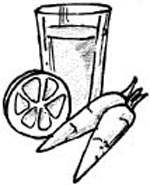
In addition to providing vital energy and nutrients, plants give us many other things.
For flavour and interest grow tomatoes and onions, chilli and mustard, red pepper, lemon sage, mint and coriander. Aim to provide all the herbs and spices the school kitchen needs.
For refreshment grow something to make refreshing drinks and snacks for children, visitors and helpers (see Drinks and snacks from the garden in Horticultural Notes).
For added value look for plants that give something extra - e.g. beautiful flowers, foliage, aromas, shade, compost, fuel, fodder, fences, medicines, natural pest repellents.
The Food Factsheets suggest how some food plants can be used in these ways. Some permanent low-maintenance crops (e.g. fruit trees, shrubs, aromatic herbs) can enhance the environment.
5. How do we grow these foods? How much can we grow? Where shall we plant them?
Together with your students, get information on how to grow the crops you have chosen, how much you can hope to grow, how much space you will need, when to plant and how to harvest (see the outline lesson Crop experts at the end of this chapter). Consult widely. This will also suggest which crops are suitable for different age groups to grow.
For each crop you have in mind, consider where to plant it, and how it will combine with others. This may mean thinking about crop rotation, intercropping, multi-layer cropping and so on (as discussed in Part 8 and in the Horticultural Notes).
| Versatile plants |
| Mint and lemon grass are used in companion planting to control pests. They also make good drinks, and an infusion of lemon grass relieves the symptoms of flu. Fresh drinks can be made from mango, guava, pumpkin, papaya, banana, oranges, lemons, carrots and tomatoes. Mixing them can improve the flavour - try carrot and orange, or pumpkin juice with lemon, orange and a little sugar. |
D. MAKING THE FINAL SELECTION
Before making your final choice of what to grow, make sure you and your pupils have consulted families, the health services, home economics teachers, agricultural services, the school meals service and the Environmental Health Officer. This will help you to make suitable choices and will also ensure that everybody knows what the choices are, and the reasons for them.
To help with this process, help your pupils to draw up a small table for each food you decide to grow. Use the questions in the outline lesson Crop experts below. This should include local information - for example, how people regard the food, how much it costs locally.
| What should your garden grow? (See p. 57) Some suggestions for schools:
|
 |
 | SUGGESTIONS FOR ACTION |
Write a description of your children’s diet in answer to the questions in A and B above. Get some ideas about how the garden can help.
Explore children’s and families’ ideas about good diet and food values.
Consult agriculture services, health services, home economics teachers and the school meals service about children’s dietary needs and what foods can remedy them.
Select several suitable crops for improving children’s diet. Help pupils to draw up factsheets for each one.
Do not make a final decision on what to grow until you have decided what to do with the foods when they are harvested (see Part 9).
 | IN THE CLASSROOM |
| Growing food crops These lessons deal with healthy diets, and what particular foods can contribute, specific food crops and deciding what to grow. They should stimulate children’s interest in homegrown food as an enjoyable experience, a source of health and a personal achievement, and make good eating a point of conversation in the home. |
N.B. It will be helpful to have a set of “food cards” with pictures of common local foods on them, made by the teacher or by the children.
1. What we eat This lesson raises awareness of variety in the diet.
Objectives Children describe their diet, become aware of how many different fruits and vegetables they normally eat and recognize the idea of variety in the diet. Teachers can use Lessons 1–3 to find out about children’s diet, their feelings about food and their ideas of “good food”.
Activities In class pupils build up a “food plate” with pictures or samples of foods (e.g. grains): the local staple food in the middle, animal foods on the left and plant foods on the right. They count the foods and say how many different kinds they eat in a day. For homework they keep a record of what they eat for a day or a week, and count the number of kinds of food.
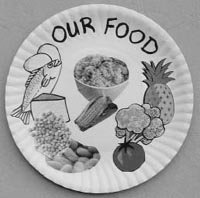
2. Good eating (1) Children and families need positive attitudes toward fruit and vegetables.
Objectives Children realize that fruits and vegetables are valuable foods, can express their personal preferences for particular fruits and vegetables, and learn to savour their smell, taste and texture.
Activities All pupils wash their hands before the lesson. The teacher shows some attractive samples of fresh fruit/vegetables, pictures and poems about them. Children say which they like best. The teacher praises positive responses and builds up the feeling of enjoyment. With eyes shut, children handle different foods and say how they feel, smell them and guess what they are, “listen” to them (shake them or break them), take a close look and describe them, then taste and eat them slowly and describe the taste. For homework they draw or describe favourite fruits and vegetables, or guess fruits and vegetables from given descriptions.

3. Good eating (2) Children act as “food missionaries” to their families.
Objectives Pupils should appreciate that fruit and vegetables are essential to health, recognize the special value of dark green leaves and red/orange fruits and vegetables, and be able to express and explain some simple messages for improving the diet.

Activities Using food pictures or samples, children place common local foods on a “good food ladder”, and give reasons. The teacher then helps children adjust these visible “food values”, explaining that all foods are good foods, but some are particularly good. Pupils pick out all dark green leaves and red/orange fruits and vegetables and move them two steps up the ladder. Older children can use the tables in Nutrition Factsheet 3 to find what particular foods are good for. Children follow up by drawing up take-home “food messages” based on lessons so far, or by making a “good food flag” with pictures of appropriate foods on green and orange stripes.
4. Food plants Children make connections between plants and foods.
Objectives Pupils are aware of the range of plants that can be eaten, are able to recognize and name the different parts of plants, and can classify foods according to the part of plant they come from.
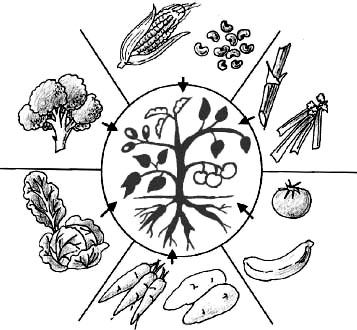
Activities The teacher makes up a bagful of foods coming from different plant parts (roots and tubers, stems, leaves, buds, flowers, fruit, seeds) and sets up labelled stations around the class for each plant part (Root Corner, Leaf Table, etc.). Pupils label a picture of a plant with its parts, then work together to classify the foods in the bag by putting them in the correct “station”. They follow up by making a labelled poster of a plant with names or pictures of foods next to each part. (Food bag idea adapted from Kiefer and Kemple, 1998)
5. What shall we grow to eat? Children should be consulted about what to grow to eat.
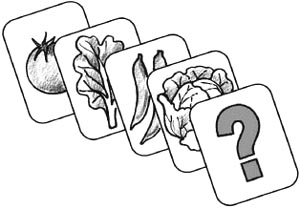
Objectives Pupils make decisions/ suggestions about what food crops to grow based on preference and understanding of nutritional value, and are able to justify their choices.
Activities Children’s suggestions about what to grow to eat are written or pictured on cards. For each card, the class discusses four questions Do we like it? Is it very good for us? Can we grow it? How can we eat it - is it delicious and easy to prepare? If all answers are favourable, the card is displayed and the final selection is made from these. Older pupils check that the selection includes a variety of foods, the necessary ingredients for some good dishes, and foods for snacks and drinks (see Snacks and drinks in Horticultural Notes). As follow-up, pupils tell families what foods they have selected and why, compile a snack book, or prepare advertising posters for the selected foods.
6. Crop experts Becoming “crop experts” gives children motivation and creates “class memory”.
Objectives Children research the crops they have chosen to grow, using several sources.
Activities Pupils recall the crops they want to plant and discuss what they need to know about them. Together the class compiles a factsheet for one crop (using the questions below). Groups then select the crop they want to study, discuss what they already know and plan to find out more from families, neighbours, local gardeners, seed packets, gardening books, etc. Students report back and pin up completed factsheets. Older students prepare a presentation or an advertising campaign.
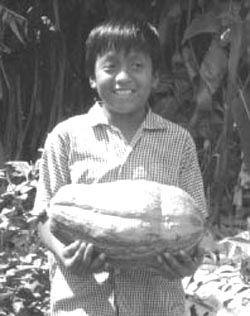
Photo: © Plenty International
Questions for crop factsheet
| (for younger children, use only the underlined questions). |
|
| NOTES |